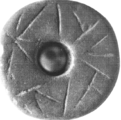BG·15
| Inscription | |
|---|---|
| Reading in transliteration: | katua |
| Reading in original script: | |
|
| |
| Object: | BG·15 Parre (spindle whorl) |
| Position: | top |
| Direction of writing: | dextroverse |
| Script: | perh. North Italic script |
| Letter height: | 0.8–1.9 cm0.315 in <br />0.748 in <br /> |
| Number of letters: | 5 |
| Number of words: | 1 |
| Number of lines: | 1 |
| Workmanship: | scratched after firing |
| Condition: | complete |
|
| |
| Archaeological culture: | unknown [from object] |
| Date of inscription: | 5th c. BC (?) [from object] |
|
| |
| Type: | unknown |
| Language: | perhaps Celtic |
| Meaning: | 'Katua' (?) |
|
| |
| Alternative sigla: | Morandi 2004: 207 |
|
| |
| Sources: | Morandi 2004: 653 f. no. 207 |
Images
Commentary
First published in Poggiani Keller 1990b: 22.
Images in Poggiani Keller 1990b: 22, fig. 9 (photo), Poggiani Keller 1991: tav. LXVIIb (photo), Morandi 2001: fig. 4 (photo and drawing, the latter = Morandi 2004: 656, fig. 24.207), Morandi 2004: tav. XXVII.207 (photo), Morandi 2007: 288, fig. 280.19 (drawing) and 296, fig. 93 (photo [mirrored along the x-axis]).
An assortment of irregular lines on one of the spindle whorl's flat side, arranged between the rim and the hole in the centre all around the surface. The putative inscription is judged to be "di difficile decifrazione" by Solinas 1995: 384, who does not offer a reading. The reading katua is Morandi's. Morandi acknowledges the existence of various "tratti parassitari", but states that they do not impede the reading. His segmentation of the collection of lines into discrete letters, however, is doubtful. The difficulty of writing in a tight circle goes only so far to explain why some of the letters are turned by 90°; putative kappa (already Poggiani Keller 1990b: 22) could be considered the ill-judged starting point of the inscription, but the position of tau is unmotivated, as is the different orientation of the two alphas (![]() vs.
vs. ![]() ). Also it must be said that the orientation of kappa would suggest the other alpha (the one that is the final letter in Morandi's reading) as the second letter.
). Also it must be said that the orientation of kappa would suggest the other alpha (the one that is the final letter in Morandi's reading) as the second letter.
Assuming that the reading is valid, Morandi's suggestion that the inscription is a votive text with a feminine name as expected on an object from the feminine sphere is feasible. Considering that Parra had strong ties to the inner-Alpine region, it must be pointed out that no clear decision can be made regarding the alphabet used in the inscription, but katua can be analysed as Celtic.
Morandi 2004: 654 and 2007: 296 f., no. 20 dates the inscription to the 4th century BC based on the shape of alpha; this is significantly lower than the archaeological dating of the find's context. A fragmentary stone spindle whorl bearing very similar marks from the San Bernardo necropolis at Ornavasso is dated to ca. the 1st c. BC (see Lanza et al. 2023: 16 f. with n. 33, 24, no. 22, with images).


